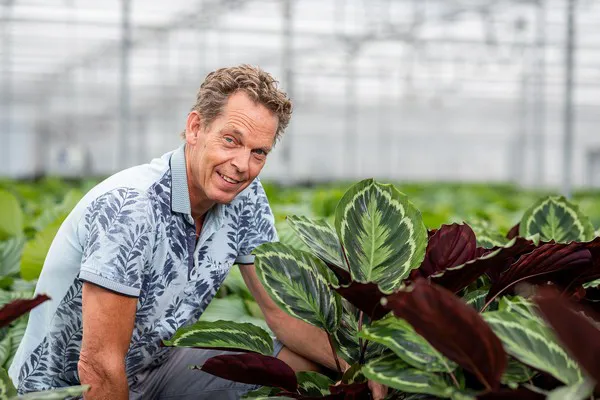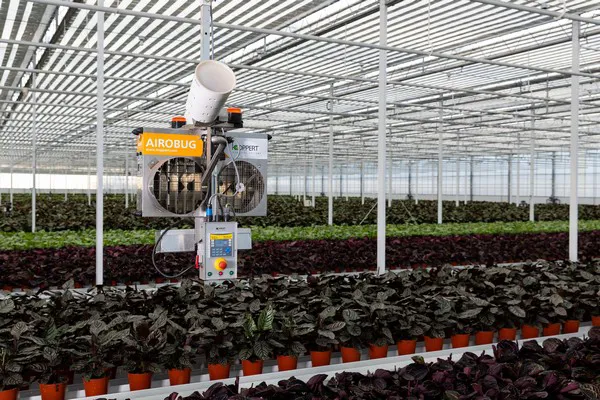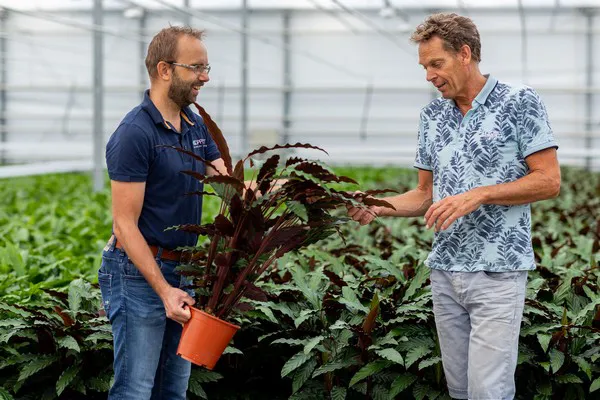Where two years ago one to two per cent of the Calatheas were unsaleable due to spider mite and thrips, virtually no plants now go into the container. "You could say that we’ve solved a problem by switching over to maximum biological use," explains Teun Valstar of Shadowplant of the revolution. The Airobug has been part of the solution.
"Two years ago, we had our backs against the wall. With the pesticides that we were allowed to use, we couldn’t get spider mite and thrips under control. It was at that point that we decided to try biological methods, around twenty per cent of the plant protection. That too proved inadequate. We were throwing away one to two percent of our plants," explains Valstar.
Shadowplant cultivates four hectares of Calatheas in Honselersdijk. Around a quarter of the area is fitted with a WPS system, with the plants growing close together in channels. This is something of a challenge for pesticides, just as it is for biological controls, since you can't walk between the gutters. It makes scouting more difficult and makes it harder to spread the beneficials from the path over the entire greenhouse.

Beneficials in the right place
The solution seemed to be the Airobug, a self-propelled blowing device specially designed by Koppert Biological Systems’ technical department for evenly distributing biological controls through the greenhouse. The Airobug is fitted with a lift, allowing it to be suspended from the monorail at the top of the greenhouse. Pots of biological controls are attached to the device and a fan blows the predatory mites out over the crops. The Airobug moves under its own power along the tubes through the greenhouse.
"As the Airobug is an in-house development, it has been designed to be safe for use with biological controls. The beneficials are spread out evenly over the greenhouse and don’t suffer when they are blown out," explains Arthur Kalkman, consultant at Koppert Biological Systems.

Cold feet
"If you spray, you see the culprits lying dead on their backs the next day. With biological controls, you need to be prepared to wait. This gives some pot plant cultivators cold feet when it comes to starting biological controls. We didn’t have the best of starts either. Two years ago, our ratio of biological controls to pesticides was 20/80, which didn't help. With pesticides, we disturbed the balance. Calatheas take 30 to 45 weeks to grow, and in that time we move them five times. Doing that merely spread the flashpoints around," explains Valstar.
Strategy
Arthur Kalkman and Teun Valstar
"When Valstar approached us two years ago, we started compiling a robust strategy – mapping the pests that cause the most pressure, what is happening with the plants in the growing process, and the most significant bottlenecks in fighting infestations. An example of this is thoroughly inventorizing the varieties that are most susceptible to spider mite. Calatheas are susceptible, but not all Calatheas equally," explains Kalkman.

Virtually no pesticides
Only a small percentage of the plant protection now used is pesticides. Spider mite and thrips can be fully controlled with biological controls, namely Spidex and Swirski-Mite. "In the spring in particular, with bright sun and wind, and the long warm summer, we’d have had a real spider mite problem. But now – nothing," explains Valstar.
"Duponchelia remains a challenge, but we’re using Macro-mite. Shadowplant also uses lamps to catch moths. ‘In some locations, we’re using green contact agents. Some infestations develop so quickly that you soon fall behind," explains Valstar.
After last year’s success with spider mite and thrips, Shadowplant started using aphid controls in some sections in 2020. It worked well, and the damage threshold was only breached once. Shadowplant plans to start aphid controls earlier next spring, allowing the Aphidend gall midge and Aphipar parasitic wasp to do their job better.
Nice work
"Our plants go to places such as IKEA, throughout Europe, and to large garden centre chains. On occasion, we receive a complaint about a bug in a plant, but now I can explain that the bug is essential. Yhat would not have been tolerated a few years ago, but acceptance is growing," explains Valstar.
Employees who work on scouting and applying the biological controls will soon be taking a three-day course at Koppert to help them recognize diseases and infestations more effectively, at an earlier stage, so that adequate intervention becomes even more feasible.
"Aside from what customers have been asking for, I was personally very eager to use fewer pesticides. It didn’t feel right, and let’s face it – spraying isn’t nice work. You always spray in the evenings, to protect staff. We don’t need to do that now, you can use biological controls in the daytime."
Cheaper on balance
Valstar continues, "Biological controls are more expensive than pesticides. As the level of infestation is lower and there is more preventive work going on, we are taking a critical look at whether we can get by with less. It is costing me less on balance. If I calculate how many hours fewer I now have to spray and how many plants we’re not throwing away, this approach is more financially appropriate."
For more information:
Koppert Biological Systems
info@koppert.com
www.koppert.com
